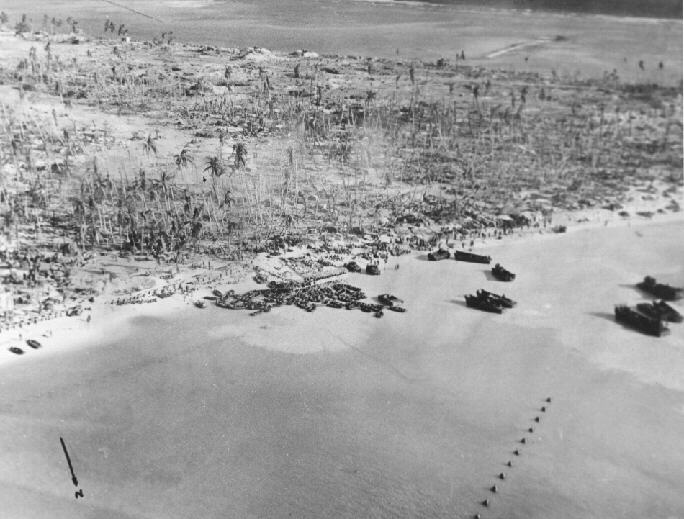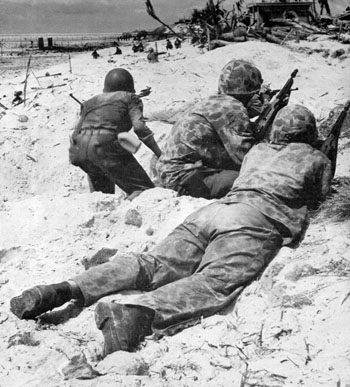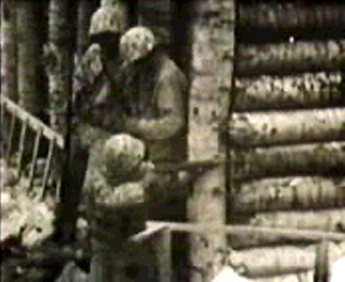The following story is from the war diary and recollections of Mr. Payton and contains graphic descriptions of some events:
WORLD WAR II STORY
By James G. Payton Jr.
I graduated from Wichita North High School in 1941. Soon after graduation I was offered a job with the American Optical Company. I accepted. In that job, I walked to each Doctor's office and to the Post Office four times a day.
On December 7, 1941, the Japanese attacked Pearl Harbor, President Roosevelt announced that we were declaring war with Japan. My boss said that he would sign up if he were younger. The Marine recruiting office was in the Post Office. Since I was in the building four times each day, I stuck my head in the recruiting office to ask them a question. They said, "come on in." They counted my teeth, checked my vision and asked me a few questions and said, "You are the type of man we want. Sign here!" I had some explaining to do with my folks and my boss. Thirty of my friends signed up also. In less than a week we were sent to Kansas City for induction into the Marines.
After our induction we boarded a train-- destination: U.S. Marine Base in San Diego, California. We entered boot training as young boys and came out men. We only thought we were men. Our true test of manhood was after one day of battle. We traveled in trucks and were taken to the dock where we boarded a large ship, called Matson Liner. After leaving San Diego and sleeping aboard ship for the first time, we awoke to find we were not alone, we saw other ships. We would notice more and more ships. We were at sea for eight to ten days. We had no idea where we were going. We landed at Pago Pago Harbor, Samoa. When leaving the U S we were issued old World War I equipment. At Samoa they issued new equipment, steel helmets and new M-1 rifles. We received jungle training in Samoa for about two months. Then boarded ships and made practice landings on the Island of Figi. (sic)
Next stop. Guadalcanal When we arrived at Guadalcanal. I worked with a group to help unload the ship. The troops had already gone ashore. While unloading the ship the Japanese attacked us, so we quickly went out to sea then returned the next morning to finish unloading. When I finally got ashore, my buddies said to hurry and dig a foxhole. (my first). I dug fast. There was an air raid in progress. Our pilots were superior and shot most of the Jap planes out of the sky. The next day we started back into the interior. The cooks would set up a chow line ahead of us. As we marched by, they would hand us our food, we would eat on the march. On one occasion, right after I passed through the chow line, a shell landed in the kitchen. We never ask questions, we just kept marching.
We finally reached the front line, and spent thirteen days in the same spot fighting. Some days we would throw our empty cans at them, they would throw them back. One day we yelled, "Tojo Eat Shit." The Japs yelled back, "Roosevelt Eat Shit." One day I was bored so I went out to do a little hunting on my own. A Zero, Jap plane, spotted me and decided to dive down and strafe me. He missed me on his first pass so he turned to try again. It was easy to avoid him and then a sniper zeroed in on me. I dove to the ground. The bullet hit some coral and shattered the coral and cut my hand, but did not break a bone. I was sent to Red Beach hospital to be treated. I spent the night alone in a trench. They told me that a hospital jeep would pick me up the next morning. I didn't sleep well that night so I was awake when the jeep came through a clearing. Shells were landing all around the jeep. They said "we have another injured man to go with you.'' They wanted me to hold him on the jeep. I noticed his skull was cracked and his brains were visible. I did my best to hold him on the stretcher and at the same time, hold his head together. He had a pulse when we reached the hospital tent. Later, he died. The doctor stitched up my hand and said, "I guess you qualify for a Purple Heart." I refused his offer. I ask them to give me a new rifle and take me back to my outfit.
Our next assignment was to march on the Japanese and drive them into the Ocean. We were sitting in a ravine waiting for orders to march. There were times when my mind played tricks on me, especially when I thought I might die at any time. My chances of surviving became a little doubtful. They told me to scout ahead. I felt they thought I was dispensable, but I always followed orders. If I saw a spot where a man could hide, I fired a round into that bush or palm tree. Later I came across some caves. They sent up a flame-thrower. The rest of my outfit came up and joined me. With the help of the flame-thrower, we flushed out many Japs. Most of them would commit Harikari. We didn't take many prisoners.
Later we were sent to another front. After a week on this front they decided to replace us. The army sent in some fresh troops. They were to go through our lines and engage the enemy. The Japanese counter-attacked the Army. They become frightened and dropped their weapons and ran back through our lines. The commanding officers were embarrassed so they told them to try again. We were told to shoot any man that would retreat again. We told ourselves we could not do that to American troops, even if it were an order. After three months on Guadalcanal; short many men, suffering from malaria, yellow jaundice, and weak from lack of food, they sent us to New Zealand for R & R and to rebuild our personnel. On my first liberty, I went into Wellington and ate five steak and egg dinners plus ice cream Sundays, milkshakes, and cream puffs in a 12 hour period.
After nine months of grueling Marine style training we were ready to tackle our next assignment. One sunny afternoon Major Crowe told us to fall in and told us, "we have been chosen to hit the Island of Tarawa." The 2nd Marines will make up the 1st wave. We will be facing 5,000 seasoned Japanese troops. Portions of the 6th Marines, 8th Marines, 10th Marines and the 18th Marines will follow us.The 1st wave is to use the new amphibian tractors. Major Crowe said. "I am honored that they feel we are capable of handling such an assignment." He said, "casualties will run about 87%.". A friend of mine did not like the odds. He decided to run away. We called it, "going over the hill." You are not considered a deserter until you have been gone a certain length of time. Our departure from New Zealand was extended one week. This young man knew that he had to report back or be could end up in prison. When he returned, they called in Major Crowe. He told him, "you do not deserve to die with the rest of the 2nd Marine Division. I want you to report on deck when we are ready to leave the ship and "watch us go into battle."
When we reached the debarkation location, it was an experience I will never forget. There were transport ships full of Marines, cruisers, battleships and aircraft carriers. We received our usual steak dinner before a battle. We did not sleep that night. We were very excited. This was my lucky day. I was assigned to the #1 amphibian tractor in the first wave. We carried 25 Marines, 1 Naval Officer and 2 tank drivers. Each man carried a lot of weight. I had full pack, full cartridge belt, two cartridgeBandoleers, rifle, bayonet and about 6 hand grenades. It was very difficult climbing down a cargo net. We left our cartridge belts and pack straps unfastened so if we fell into the water, we could get out of them in a hurry. Some men lost their lives, either drowning or being crushed between the ship and the landing craft. We were the 1st to use the new amphibian tractors. There was a coral reef 1,000 yards out from shore. They knew the tide would be low. The Amphibian tractor would climb over the reef where as the regular landing craft would be forced to stop at the edge of the reef. That would force the men to wade 1,000 yards in 2 to 3 feet of water to reach the shore. That would be disastrous. The order was given to leave the ship. Sure enough, there stood the young man who was being punished for going AWOL. He was crying like a baby.
We climbed down the cargo nets and got into our assigned boats. We went in circles waiting for all the boats to get loaded and find their position. I marveled at the ability to arrange an operation as massive as this. The battleships began firing their big guns. You could see the red-hot shells pass over our heads. They looked to be the size of a Volkswagen car. We were in position at three o'clock just as they planned. At that time we were in single-file formation. When close to the reef, we made a left turn until we were parallel to the reef and the shoreline. Our tractor was on the extreme left flank. We started in and "all Hell broke loose." I was loading one of two 50-caliber machine guns we had mounted on the front of our tank. After traveling about 10 yards and passing over the reef, we were hit. The two men driving the tank fell back against my legs. They were dead. The Marine shooting the machine gun I was loading "exploded like a light-bulb." I was stunned for a moment and then I came to and decided it was time to get out of this thing. To my surprise, my friend from my hometown and the navy Lieutenant also got out. The tractor took two more direct hits. I knew all the men inside were dead. The Lieutenant had lost part of his face. He died. I looked at my friend; bullets were splashing all around him. I was sure the same thing was happening to me also. I said, "Bud, let's head for the beach." He said you go first and l will follow. I took about two steps. My right leg flew up over my head. I was sure it was broken. To this day, I will never know how we made it to the beach.
We managed to hold on to our rifles, so we were able to engage the enemy. Later that morning, a medic gave me a shot of morphine and put sulfa powder and a bandage over the hole in my leg. That morphine caused me to fall asleep at times right in the middle of action. The severe fighting was just about over by the end of the second day. The remainder of the battle was digging the Japs out of their concrete bunkers. There were 1,027 Marines killed and 2,292 were wounded. All but about one-half dozen of the 5,000 Japanese were killed. At the end of the second day my friend, Bud West, (shown with me in older photo) located two corpsmen with a stretcher to carry me to a transport ship setting off shore.
When they finally got me on board, they laid me on a table and started working on my neck. That injury was caused when the hot barrel from the machine gun I was loading on the amphibian tractor landed on my neck. Coral infection caused it to look worse than it really was. l told them they were working on the wrong spot. I said it's my leg. The shell broke the tibia bone and severed the nerves in my right leg. They cleaned and bandaged it, then put me down in the hold of the ship. This was very depressing. There was very little light down there. I assumed there were other men down there also. I think there was a priest there also.
While in New Zealand, I purchased a chain with a cross on it. I had it around my neck. I was in pain and depressed, so I pulled the cross and chain from my neck and threw it to the floor. The priest saw this and the next I knew they moved me up topside where it was cooler and more pleasant. During the time I spent on the Island and aboard the ship, I had no recollection of time and occasionally I would pass out. They had me drugged. I am sure they put me in a stretcher and moved me from one ship to another on a cable. I ended up in a beautiful all white hospital ship. They put a cast on my right leg up to my hip. I don't know how long I was on that ship.
The next thing I knew we were in Hawaii. I stayed in a hospital there for five days, then we boarded another ship. I ended up in San Francisco where they put me on a train to Corona, California. I spent 18 months in Corona, California. My right leg was paralyzed, so I underwent four different surgeries and a lot of therapy so I could walk again. They gave me $300 separation pay, a Purple Heart and sent me home.




Send an Email:
copyright 2012 T.O.T.W.
Created 29 December 2012
